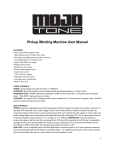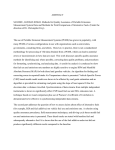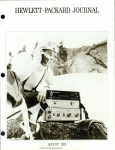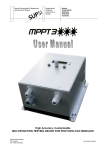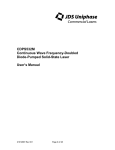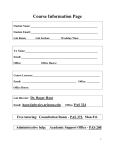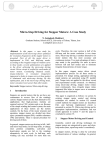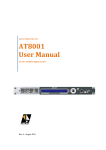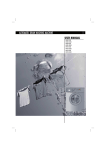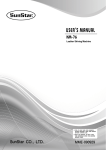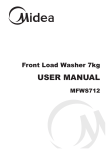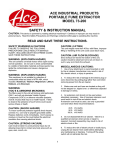Download Here - Tube Amp Doctor
Transcript
Pickup Winding Machine User Manual FEATURES Heavy duty 24VDC geared motor High efficiency dual H bridge motor driver uController controlled speed, direction, and turns Approx 1200 RPM max speed Magnet gauss sensor Backlit blue LCD screen Powder coated metal casing Optional foot control 110v to 220vAC adaptor Adjustable manual traverse Universal pickup mounting jig FRONT CONTROLS SPEED Controls speed manually from 0240. (~01200rpm) PROGRAM Opens the program mode for editing and saving winding direction or number of turns. DOWN/RUN STOP “DOWN” changes winding direction and number of turns in program mode. “RUN STOP” starts and stops run mode. UP/GAUSS “UP” changes winding direction and number of turns in program mode. “GAUSS” opens and closes the gauss sensor mode. SIDE CONTROLS SPEED (control out) Bypasses manual front panel speed control for optional foot pedal (not included). This jack is a standard TRS connection ofr 5V control voltage. 5Vdc is wired to the tip 0Vdc is wired to the sleeve and the ring connection expects 05Vdc which is used to set the speed of the unit. At 0vDC the motor shaft is in “coast” state. Any control voltage pedal can be used although all testing was done with a Behringer FCV100. A volume pedal can also be used but requires custom wiring of 2 x ¼” TS plugs to 1 ¼” TRS plug. Care must be take to connect this cable so that the input tip is connected to the TRS tip and the output tip to the TRS ring. It is possible to damage the unit or your volume pedal if this wiring is not fully understood so we can only recommend the use of a FCV100 and a TRS cable. RUN STOP This is a footswitch jack for the RUN Stop button on the front panel. It is a 2 wire connection where the tip is momentarily grounded to the sleeve to control Run mode. It is notable that coming out of Run mode or ending the turns count which also exits run mode “brakes” the motor instead of “coast”. GETTING STARTED Attach Mounting Jig Attach universal bobbin mounting jig to the winding machine mandrel disc using the 632 screws and keps nuts supplied. 1 Attach Bobbin After mounting the universal bobbin jig to the mandrel, attach the bobbin to the mounting jig by sliding the center hole of the bobbin over the threaded post. For bobbins without center holes, use the closest hole to the center. Remember the bobbin is not perfectly round, so mounting perfectly on center is not critical as the bobbin is spinning oblong anyway. Then attach the U channel clamp over the threaded rod and bobbin so that the hollow channel goes over any staggered magnets if need be. Then attach the wing nut and tighten enough so that the bobbin will not spin. Do not overtighten as it may crush the bobbin. Power on Plug power adaptor (included) into the machine and then into the wall outlet. The green light on the adaptor will illuminate showing there is power. Turn the machine on and you will see the LCD display screen light up blue with moving text “Mojotone P’up Winder V1.0”. Then the display will read “Dir C Speed 0240 Turns 5000” PROGRAMMING Step 1: Press “PROGRAM” to open program mode. It will ask you “Use Last Prog? Down=No Up=Yes.” Here you can choose your starting point for programming the desired number of turns at 5000 or 7000 turns. These starting points make it faster to set the desired number of turns so you don’t have to start off at 0 each time. Step 2: Refer to A or B A) Push “DOWN” to start programming at 5000 turns (skip steps 3 and 4). B) Push “UP” to start off at 7000 turns (continue with steps 3 and 4). Step 3: Press “PROGRAM” again and your display will read “Use Last Prog? Down=No Up=Yes.” Step 4: Press “DOWN” to program starting off at 7000 turns Step 5: Press “UP” to change winding direction to “CC” Counter Clockwise rotation, and press “DOWN” for “C” Clockwise rotation. Step 6: Press “PROGRAM” to save the winding direction and edit the number of turns. Step 7: Use the “UP” and “DOWN” buttons to change the number of turns. Hold the button and it will start counting up or down in increments of 1’s, then 10’s, then 100’s until the desired number of turns is met. Step 8: Once you arrive at the desired number of turns you can press “PROGRAM” again to save the number of turns. Now the display will show the winding direction and number of turns you have saved. START WINDING After setting your program to the desired winding direction and number of turns, you can begin winding the coil. To begin, press “RUN STOP” to run the saved program. Make sure that you have the speed control set at 0 before starting or it will immediately jump to the set speed and may result in wire breakage. Slowly increase your speed using the speed knob or optional foot control pedal to the desired speed. You can adjust speed up or down from 0195 anytime during the program. The machine will stop immediately at 0 turns after the program is finished, so it is recommended that you slow the speed down as your number of turns approach close to 0. Once the machine stops at 0, you can choose to run the same program again by pressing “PROGRAM”, then it will display, “Use Last Prog? Down=No Up=Yes.” Press “UP” to run the last program again, or press “DOWN” to program a different winding direction and number of turns from the last saved program. NOTEOnce you turn the machine off and back on again, the saved program will be erased and you will need to begin from Step 1 again under PROGRAMMING section. WINDING PARAMETER Set your winding parameter at a slow speed by adjusting the traverse collars in or out until the wire feeds just inside the top and bottom of the bobbin flanges. Tighten the set screws gently after the desired parameter is set. Now you can feed the wire in between the collars to build the coil evenly. We recommend feeding the wire under the bar for “C” Clockwise bobbin rotation, and over the bar for “CC” Counter Clockwise bobbin rotation. GAUSS SENSOR Press “GAUSS” button to open the gauss sensor mode. Press again to exit the gauss sensor mode. You must stop the current program you are running before entering the gauss sensor mode. The gauss sensor selfcalibrates to “0” so you cannot have a magnet touching the sensor until after you open the gauss sensor mode and it shows calibrated to “0”. Place the magnet or directly against the center of the sensor on the top of the machine labeled “GAUSS SENSOR” to read the polarity and gauss level. The magnet side touching the sensor is displayed as North or South polarity. Placing very large magnets (speaker magnets for example) on the gauss meter will cause the LCD screen to be disrupted and is therefore not recommended. 2 NOTE***Please understand that gauss levels are relative readings (based on whatever meter you are using and how it was calibrated) and should not be compared with readings stated by other gauss meter or magnet manufacturers. We recommend you measure only with our gauss sensor to record readings of fully magnetized magnets if you want to compare gauss levels. It is perfectly normal to see slight variations of gauss levels throughout the entirety of the magnet or even stronger gauss readings from the edges. If the gauss level shows a significant difference, say 50%, make sure you try repositioning the magnet on the sensor until the highest number is achieved. If you continue to get major differences in gauss readings, try remagnetizing the magnet and repeat the above until relatively consistent readings are achieved. WINDING TIPS Super glue your flatwork and magnets together. This strengthens the assembly of the bobbin and helps prevent moisture from getting between the flatwork and magnets. Sand or scrape any rough edges on the bobbin before winding to prevent wire snags or breakage. Tape your magnets on Fender style single coil bobbins. Thin paper tape works well and helps prevent dead shorts directly against the magnets. Feed the coil wire off of one end of the spool from the floor. A small plastic container with a smooth edged center hole (grommet) in the lid to feed the wire through helps prevent wire from flying out and catching something as it feeds off of the spool. Use felt on your fingers to tension the wire between. WARRANTY Mojotone’s warranty obligations are limited to the terms set forth below: Mojotone, as defined below, warrants this Mojotone branded winding machine against defects in materials and workmanship under normal use for a period of ONE (1) YEAR from the date of retail purchase by the original enduser purchaser (“Warranty Period”). If a defect arises and a valid claim is received within the Warranty Period, at its option, Mojotone will either (1) repair the hardware defect at no charge, using new or refurbished replacement parts, or (2) exchange the product with a product that is new or which has been manufactured from new or serviceable used parts and is at least functionally equivalent to the original product. Mojotone may request that you replace defective parts with new or refurbished userinstallable parts that Mojotone provides in fulfilment of its warranty obligation. A replacement product or part, that has been installed in accordance with instructions provided by Mojotone, assumes the remaining warranty of the original product or ninety (90) days from the date of replacement or repair, whichever provides longer coverage for you. When a product or part is exchanged, any replacement item becomes your property and the replaced item becomes Mojotone’s property. EXCLUSIONS AND LIMITATIONS This warranty does not apply: (a) to damage caused by use with nonMojotone products; (b) to damage caused by accident, abuse, misuse, flood, fire, earthquake or other external causes; (c) to damage caused by operating the product outside the permitted or intended uses described by Mojotone; (d) to damage caused by service (including upgrades and expansions) performed by anyone who is not a representative of Mojotone; (e) to a product or part that has been modified to significantly alter functionality or capability without the written permission of Mojotone; (f) if any Mojotone serial number has been removed or defaced. OBTAINING WARRANTY SERVICE Service options, parts availability and response times will vary according to country. You may be responsible for shipping and handling charges if the product cannot be serviced in the country it is in. In accordance with applicable law, Mojotone requires that you furnish proof of purchase details before receiving warranty service. © Copyright 2014. Mojotone® is a registered trademark of Nothing Shocking LLC DBA Mojo Musical Supply. 513 South Dudley St, Burgaw, North Carolina 28425 Toll Free: (800) 9276656 Local: (910) 2597291 Fax: (910) 2597292 Website: www.mojotone.com 3



